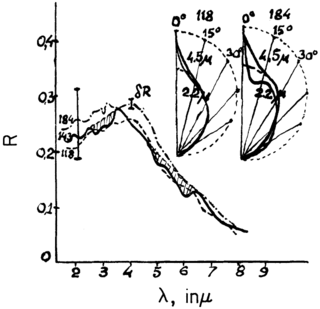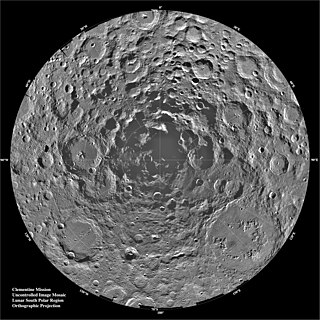
Lunokhod 2 was the second of two unmanned lunar rovers that landed on the Moon by the Soviet Union as part of the Lunokhod programme.
The Lunar Precursor Robotic Program (LPRP) is a program of robotic spacecraft missions which NASA has used to prepare for future human spaceflight missions to the Moon by 2010. Two LPRP missions, the Lunar Reconnaissance Orbiter (LRO) and the Lunar Crater Observation and Sensing Satellite (LCROSS), were launched in June 2009. The lift off above Cape Canaveral Air Force Station in Florida was successful on June 18, 2009. The unmanned Atlas V rocket launched the two space probes towards the Moon, where they will provide a 3-D map and search for water in conjunction with the Hubble Space Telescope.

Colonization of the Moon is a concept employed by some proposals of establishing permanent human settlement or robotic presence on the Moon, the closest astronomical body to Earth, and the Earth's only natural satellite. However, the term colonization can have negative implications and therefore its use for space has been questioned, some suggesting more basic concepts such as space settlement or space habitation.

Shackleton is an impact crater that lies at the south pole of the Moon. The peaks along the crater's rim are exposed to almost continual sunlight, while the interior is perpetually in shadow. The low-temperature interior of this crater functions as a cold trap that may capture and freeze volatiles shed during comet impacts on the Moon. Measurements by the Lunar Prospector spacecraft showed higher than normal amounts of hydrogen within the crater, which may indicate the presence of water ice. The crater is named after Antarctic explorer Ernest Shackleton.

Chandrayaan-1 was the first Indian lunar probe under Chandrayaan program. It was launched by the Indian Space Research Organisation in October 2008, and operated until August 2009. The mission included a lunar orbiter and an impactor. India launched the spacecraft using a PSLV-XL rocket on 22 October 2008 at 00:52 UTC from Satish Dhawan Space Centre, at Sriharikota, Andhra Pradesh. The mission was a major boost to India's space program, as India researched and developed its own technology in order to explore the Moon. The vehicle was inserted into lunar orbit on 8 November 2008.

Peary is the closest large lunar impact crater to the lunar north pole. At this latitude the crater interior receives little sunlight, and portions of the southernmost region of the crater floor remain permanently cloaked in shadow. From the Earth the crater appears on the northern lunar limb, and is seen from the side.

Cabeus is a lunar impact crater that is located about 100 km (62 mi) from the south pole of the Moon. At this location the crater is seen obliquely from Earth, and it is almost perpetually in deep shadow due to lack of sunlight. Hence, not much detail can be seen of this crater, even from orbit. Through a telescope, this crater appears near the southern limb of the Moon, to the west of the crater Malapert and to the south-southwest of Newton.

Lunar water is water that is present on the Moon. It was first discovered by India's ISRO Chandrayaan-1 mission in 2008. Diffuse water molecules can persist at the Moon's sunlit surface, as discovered by NASA's SOFIA observatory in 2020. Gradually water vapor is decomposed by sunlight, leaving hydrogen and oxygen lost to outer space. Scientists have found water ice in the cold, permanently shadowed craters at the Moon's poles. Water molecules are also in the extremely thin lunar atmosphere.

The Lunar Crater Observation and Sensing Satellite (LCROSS) was a robotic spacecraft operated by NASA. The mission was conceived as a low-cost means of determining the nature of hydrogen detected at the polar regions of the Moon. Launched immediately after discovery of lunar water by Chandrayaan-1, the main LCROSS mission objective was to further explore the presence of water in the form of ice in a permanently shadowed crater near a lunar polar region. It was successful in confirming water in the southern lunar crater Cabeus.
A cold trap is a concept in Planetary Sciences that describes an area cold enough to freeze (trap) volatiles. Cold-traps can exist on the surfaces of airless bodies or in the upper layers of an adiabatic atmosphere. On airless bodies, the ices trapped inside cold-traps can potentially remain there for geologic time periods, allowing us a glimpse into the primordial solar system. In adiabatic atmospheres, cold-traps prevent volatiles from escaping the atmosphere into space.

The Lunar Reconnaissance Orbiter (LRO) is a NASA robotic spacecraft currently orbiting the Moon in an eccentric polar mapping orbit. Data collected by LRO have been described as essential for planning NASA's future human and robotic missions to the Moon. Its detailed mapping program is identifying safe landing sites, locating potential resources on the Moon, characterizing the radiation environment, and demonstrating new technologies.

The lunar south pole is of special interest to scientists because of the occurrence of water ice in permanently shadowed areas around it. The lunar south pole region features craters that are unique in that the near-constant sunlight does not reach their interior. Such craters are cold traps that contain a fossil record of hydrogen, water ice, and other volatiles dating from the early Solar System. In contrast, the lunar north pole region exhibits a much lower quantity of similarly sheltered craters.

Erlanger is a very deep lunar impact crater that lies close to the Northern pole. Due to its position near the north pole of the moon, sunlight only rarely falls on the bottom, and the 2008 Chandrayaan-1 probe hoped to find that ice from comet impacts had accumulated there. Erlanger is one of the lunar craters of eternal darkness.

The Miniature Radio-Frequency instrument (Mini-RF) is a synthetic aperture radar (SAR) instrument on the Lunar Reconnaissance Orbiter (LRO), which is currently in orbit around the Moon. It has a resolution of 30 m/pixel and two wavelength bands, a primary band at 12.6 cm and a secondary band at 4.2 cm. The original principal investigator of Mini-RF, Stewart Nozette, was arrested for espionage. Nozette was replaced by Ben Bussey, then of APL, the Applied Physics Laboratory where Mini-RF was assembled from components developed by a consortium of industry team members. Bussey accepted a position at NASA Headquarters and was replaced by the current principal investigator, Wes Patterson, also of APL. Previous SAR instruments, such as the radar on the Magellan mission to Venus, were large, massive, power-hungry, and expensive. Intended as a demonstration of cheap, lightweight SAR technology, the Mini-RF instrument was designed in response to these concerns. Because it was a technology demonstration, Mini-RF is sometimes not included in lists of LRO's instruments.

An irregular mare patch also known as an IMP, is a smooth, rounded, slightly mounded area, generally about 500 meters wide, occurring in the lunar maria.

The Lunar Flashlight is a planned low-cost CubeSat lunar orbiter mission to explore, locate, and estimate size and composition of water ice deposits on the Moon for future exploitation by robots or humans.

Lunar Polar Hydrogen Mapper, or LunaH-Map, is one of 13 CubeSats planned to be launched with Artemis 1 in 2021. Along with Lunar IceCube and Lunar Flashlight, LunaH-Map will help investigate the possible presence of water-ice on the Moon. Arizona State University began development of LunaH-Map after being awarded a contract by NASA in early 2015. The development team consists of about 20 professionals and students led by Craig Hardgrove, the Principal Investigator.
The following outline is provided as an overview of and topical guide to the Moon:
















